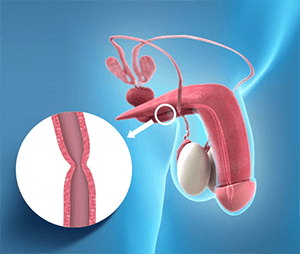
Urethra
The urethra is a tube through which urine, stored in the bladder, is passed outside the body. A urethral stricture is an abnormal area of constriction along the length of the urethra that reduces or obstructs the flow of urine. It is more common in males as the urethra is longer, passing through the penis and prostate gland.
Urethral Strictures
Urethral strictures usually occur due to inflammation and scar formation in the urethra. This can occur for many reasons, such as trauma from catheters or other objects placed into the urethra, external injury, infection, inflammation, or passage of kidney stones. About half of men with stricture have no clear cause. . Those with enlarged prostates and sexually transmitted disease such as gonorrhea and syphilis have an increased risk of developing a stricture.
Symptoms
The symptoms that accompany a urethral stricture include:
- Reduced urine output or inability to urinate
- Weak stream
- Urethral discharge
- Pain during urination or in the pelvic or lower abdominal region
- Incontinence (inability to control urine)
- Swelling of the penis
- Blood in the urine
- Epididymitis or orchitis (inflammation of the testicle and epididymis)
Diagnosis
When you present to the clinic with these symptoms, your doctor will review your medical history and perform a physical examination of the penis or tissue overlying the urethra for swelling, redness and hardened areas. Urine flow is also evaluated. Urine tests are performed to determine the presence of infection. The opening of the urethra is measured and a cystoscope (flexible camera) may be inserted to examine the urethra and bladder.
Treatment
Multiple treatments are available for urethral stricture. Shorter strictures may be treated with urethral dilation or cutting the scar tissue in a procedure called a direction vision internal urethrotomy (DVIU). This may be combined with injection of medication to reduce scar recurrence. For larger strictures, or those that recur after a surgical treatment, your doctor may recommend a urethroplasty. This involves removing and reconstructing areas of stricture, sometimes using tissue grafts from other parts of your body. For older men with severe disease, a perineal urethrostomy may be recommended. This diverts the urethra to the skin behind the scrotum. While it requires sitting down to urinate, it also avoids multiple surgeries and the risks of complications.
